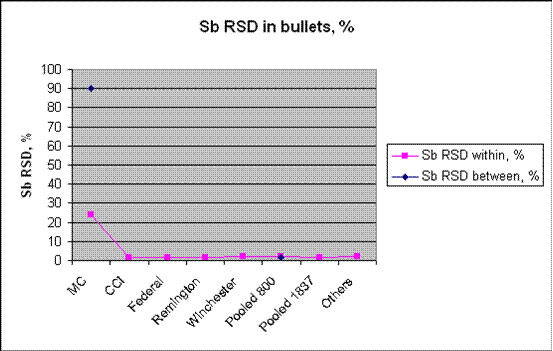
Do We Really Need To Know Metallurgy In Order To Get The Right Answer?
This article insists throughout that people
have to know metallurgy in order to understand the elemental data from the
fragments in the JFK assassination. A typical quote: "An investigator cannot
interpret the compositional analyses without regard to the realities of bullet
production." The article then proceeds to use metallurgy and get the wrong answer. This
may mean either that metallurgy is not essential, or that it just used the
metallurgy
wrongly. I think that both are true. The previous pages showed that the article jumped to
a wrong conclusion from metallurgical reasoning. The next paragraphs show that
one really does not need to know much, or maybe anything, about metallurgy in
order to interpret the fragments properly.
As an exercise, let us see how far we can go in interpreting
the elemental data for the JFK fragments without appealing to metallurgy. First
we can note that at the size of the smallest fragments, antimony is nearly
homogeneous in the lead (heterogeneities of <6%, which is at the level of the
analytical uncertainties). No surprises here. Next we can note that at the
quarter-bullet scale, its heterogeneity has risen to 24%, well above the limit
of detection. We then note that when we move upward to the bullet scale, its
heterogeneities increase further, to 40% or 90%, depending on whether the base
is three bullets or 14 bullets.
There is an important feature here that is easy to miss.
Since the 14-bullet results were derived from one sample per bullet, one might
say that they do not represent anything larger than the quarter-bullet scale of
the three bullets. In fact, that position cannot be excluded from the 14 points
alone. But the quarter-bullet analyses give the lie to that idea—they
clearly show that entire bullets can be high, medium, or low in antimony. Thus
the size scale for heterogeneities in antimony extends to at least the size of whole
bullets. Unfortunately, the available data cannot show whether it extends to
greater sizes. If the data from the 14 bullets can be taken at face value,
however, it would strongly appear that the heterogeneities go well beyond the
size of individual bullets. That conclusion cannot yet be proven, however.
Thus the bigger the sample of WCC/MC lead, the more it will
differ in antimony from other samples of the same size. What are we to do with
this difference? First, we can note that these differences can be dealt with
statistically as long as they fit one of the well-known distributions. In the
second Rahn-Sturdivan paper, Larry Sturdivan showed that they follow a
log-normal distribution, which is the same distribution followed by the many
lead samples considered in the 2004 NRC report. The only difference is a much
bigger standard deviation for the WCC/MC leads. Second, we can go ahead and use
the properties of this distribution to interpret the results, and in particular
demonstrate the reality of the two obvious groups of JFK fragments. (See the
Rahn-Sturdivan page here.)
The much-bigger heterogeneity of MC lead is shown in the
figure below (also from the first Rahn-Sturdivan paper), which compares
within-bullet relative standard deviations (RSDs) of MC lead with several
classes of bullets considered in the NRC report. Note how different the MC lead
is.

Notice how far we have come
without having to know a thing about metallurgy. We have established that
antimony in MC lead varies progressively more as the size of the fragments
increase, that the variations follow a log-normal distribution, and that the
variations are far larger than reported for other types of bullets. That is
really all we have to know in order to properly interpret the data from the
fragments—all without metallurgy.
But we don't want to be complete ostriches and ignore
metallurgy completely just because we can. We can use it to take further
steps. It is quite natural to wonder about the reasons for the large-scale
heterogeneities in antimony. To get a general (operational) answer, we need know
nothing more than that the Western Cartridge Company made MC lead by mixing
scrap lead (some of which was rich in antimony because it came from other
castings for hardened bullets) with virgin lead (very low in antimony), and that
complete chemical homogenization was not necessary to meet the terms of the
contract. Thus the final product was "clumpy" in antimony, and to a lesser
extent in the other elements associated with the scrap material. It matters not
whether you view the resulting vat as mixed like a marble cake, as I have opined
in the past, or containing "nuggets" of high-antimony material, as Tony Marsh
has suggested. The critical things are the scale of the heterogeneities and
whether the resulting concentrations follow a reasonable statistical distribution.
In other words, you don't really have to know about
metallurgy to interpret the data properly, but it is nice to have a little for
backup at the end.